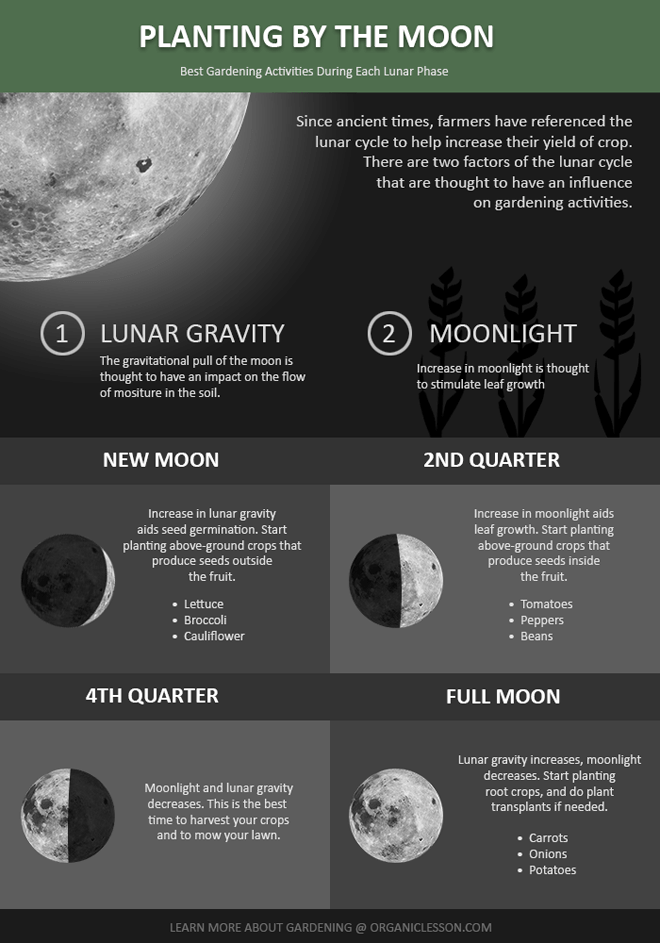When you know what to plant next to this or...
About Planting By The Moon
Long before the advancement of technology, gardeners and farmers during ancient times relied on other principles to guide their agricultural efforts. The lunar cycle was one of many important principles that farmers relied on to perform specific gardening activities such as seed sowing, transplanting, and pruning. Today, you will come across many gardeners who still swear by this method.
Applying the lunar cycle to your gardening efforts is very simple and there are no real major downsides to trying it out. In the following infographic by Organic Lesson, you can learn the basics of planting by the moon and also learn about the factors of the cycle that affect gardening.

There is actually more than one type of lunar gardening principles but the most common one is called the synodic method. The other methods are called the biodynamic method and the sidereal method. Those methods are less common as they require a strong knowledge of astrology. For example, the biodynamic method uses the constellations in the sky in order to determine when one should engage in specific gardening activities. The synodic method, on the other hand, only requires gardeners to know what period of the lunar cycle their location is in. That information can be easily found online on websites that feature information on different time zones.
To truly understand how the synodic method works, it is important to know the main factors of the moon that affects gardening. The most important factors are the gravitational pull of the moon and the intensity of the moonlight. The intensity of each factor varies by each of the four lunar phases.
New Moon
The first phase of the lunar cycle is called the new moon. During this particular period, the sun and moon are in approximate alignment. As a result, the gravitational pull of the moon increases.
Based on Newton’s Law of gravity, researchers suggest that the flow of moisture in the soil becomes more efficient as the gravitational pull increases. Since plants, like any other living organism, require water to grow and survive, the greater efficiency of the moisture flow aids the growth of the plant. For gardeners, the recommendation during the new moon is to start growing above-ground crops like lettuce, broccoli, and cauliflower.
2nd Quarter
In the 2nd quarter of the lunar cycle, the intensity of the moonlight starts to increase with the alignment of the moon and sun moving further apart. According to one theory, moonlight aids seed germination and leaf growth. Hence, it is recommended for gardeners to start growing above-ground crops that produce seeds inside the fruit like tomatoes and beans.
It is also recommended that you start growing leafy plants like lettuce and spinach. During the 2nd quarter, it is thought that the increasing energy of the moonlight is directed into the leaves, which aids processes like photosynthesis.
Full Moon
During the full moon, gravitational pull of the moon starts to increase again, while the intensity of the moonlight starts to decrease. Since there isn’t much to gain from the moonlight, it is recommended for gardeners to start planting root crops like carrots and potatoes. If needed, gardeners should also do their plant transplants during this particular period because the efficiency of the moisture flow is getting strong again.
4th Quarter
During the 4th quarter, both the intensity of the moonlight and lunar gravity starts to decrease. There isn’t much to gain when you start to grow new plants during this particular period. Hence, it is recommended that this is the best time for gardeners to harvest crops. If you own a real lawn, it is also recommended that you mow the grass during the 4th quarter of the lunar cycle.
When you read more about this topic, it definitely helps to understand common terms that apply to lunar gardening. For example, two terms used often for the lunar cycle are waxing and waning. When the moon goes through a waxing phase, this means that the illumination of the moon is increasing.
Waning, on the other hand, refers to when the illumination of the moon decreases. Hence, the time period between the new moon and 2nd quarter is most often referred to as a waxing phase, while the period between the 2nd quarter and the full moon is referred to as a waning phase.
Ultimately, the gardening choices you have to make would also differ by location. For example, if you have one gardeners living in Northern Canada and another living in the South of the United States, they won’t necessarily be able to grow the same types of crops since other important factors have to be taken into account such as the soil type and weather condition. If you do decide to reference the lunar cycle the next time you start a garden, think of it as one of many important strategies that you would consider to maximize the yield of crop.







